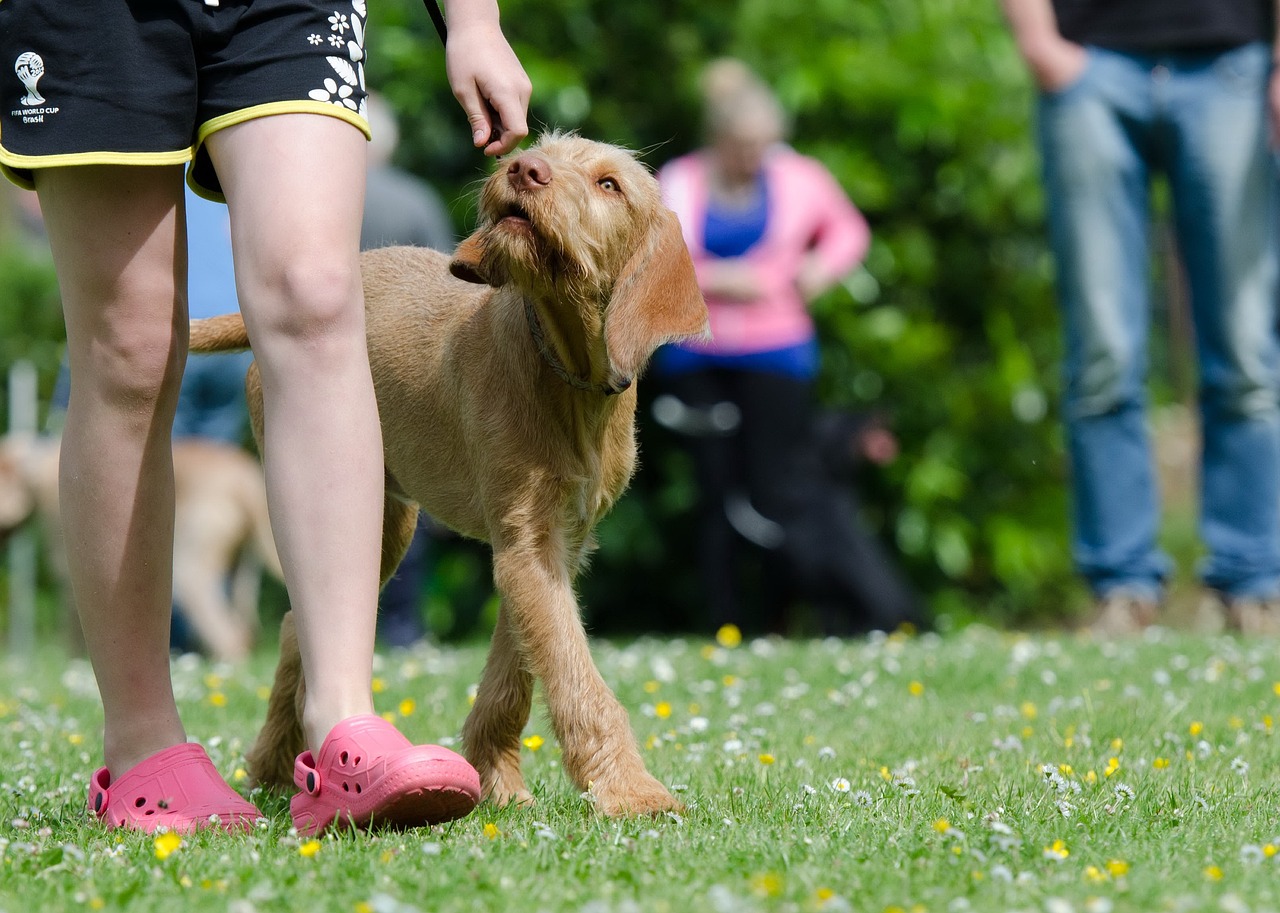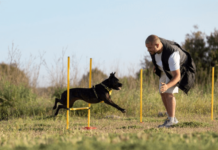Last Updated on June 13, 2024 by Dogs Vets
Pet parenting is an all-day job with the unique perks of unconditional love and loyalty.
Like a doting parent, you always want to give your pup the best of both worlds, making their daily life enjoyable and healthy. It also entails building a safe environment for them.
However, dogs need to adjust to the new environment and behave accordingly. That’s where training plays a critical role.
A Fido is taught certain mannerisms and behaviors that make their transition into your home easy and enable them to communicate better.
However, everyone wonders if they should start with verbal cues or hand commands. The fact is it’s all about personal preferences.
Still, hand signal training has its benefits. Scientific research suggests that hand commands are often more effective than verbal hints. That could be why 89% of dog owners attempt to teach hand commands to their canines.
Reasons for considering hand signal training for dogs
The foremost factor is body language, which is the dog’s natural way of communication.
Hence, they can promptly learn body cues and respond. Verbal cues can be difficult to pick. A study was conducted on some dogs trained in standard visual and auditory commands. The findings revealed that hand-based cues were up to 99% more reliable than voice commands, demonstrating 82% reliability.
Sometimes, you and your dog will up face a noisy environment. Think of house parties or time in dog parks and other public spaces. In those surroundings, body cues can be much easier for them to catch and interpret than voice commands. They can read gestures even from a distance.
Hearing loss or weakening can occur in aging dogs. You can still guide them in those tough times with your hand movements.
Suppose you give the responsibility of taking your dog to a neighborhood park or providing care to him to another person in your absence. Since accents, tones, and intonations drastically vary from person to person, dogs can quickly get confused with verbal commands. However, visual signals will still be highly reliable regardless of the handler. Generally, training centers teach both visual and auditory clues to canines.
Standard hand signal training for dogs
Do you have a list of dog commands & hand signals for beginners? Don’t stress if you still need to refer to one. It starts with hand signals for sit, come, down, wait, stay, heel, drop, etc.
1. Sit
In the beginning, you can train your dog to sit. If you take your dog on a stroll and have to wait for the traffic to stop, this simple visual cue will be handy. Various techniques are available.
One way you can do this is by bringing your hand near the chest and raising it to the shoulder level.
If your dog rests its bottom on the floor while seeing this, you can treat him to reinforce the outcome.
Or, you can stretch your arm out and move your hand above and over the canine’s nose to encourage him to sit. The same command can also be used when you meet a new person at home or outside in your dog’s presence.
2. Stay
Teaching your dog to ‘stay’ with a simple hand command is essential to making him patient or control himself. It begins with gesturing for him to sit.
After this, you can extend your hand in front with an open palm and utter ‘stay.’ When the dog remains in its position, you can praise him. However, one should repeat this while increasing the time and distance.
3. Come
Another critical hand command is “come.” It would help if you taught this essential visual and verbal cue for your pup’s safety.
A verbal cue will be impactful if the dog runs in the other direction, and a visual cue will help if it’s hard of hearing.
In this recall training, you use the open hand on your side, sweeping it diagonally towards the opposite shoulder. Once the dog comes to you, remember to praise and treat him.
4. Heel
The next hand cue for your pup can be the heel. This signal reminds your dog to come to the starting position. You can tap on the right or left leg or hip to indicate that it must come to that side.
If it does, the dog deserves a reward. A heel signal can be used when you take your four-legged friend on a walk, and it changes its position. When you command him, the dog will resume the position. Again, it can be signaled in different ways. So, you can go with your preferred style.
5. Leave it or drop it
Once the heel training ends, you can prepare your pup to learn the drop or leave it hand command. This command feels handy when your pet touches or eats an unwanted thing. How do you show this? Make a fist facing the ground, and then open your hand.
6. Down
It’s to calm him down or to encourage him to stay calm. When dogs lie down, they can remain in that position for an extended period.
You can teach them to stay down if you are busy doing something, such as cooking dinner. Or, you want to prevent them from indulging in begging behavior.
This command can also be used in advanced hand command training for crawling, rolling over, etc. So, you can gesture your dog to lie down by extending your arms out and moving them to the floor. Some people use index fingers to point to the floor while moving their arms down.
The success rate of hand command training
As hinted earlier, about 91% of people have tasted success with visual cue training with dogs, per a credible survey. Suppose you own a Border Collie or an Australian cattle dog.
In that case, you can expect your endeavor to yield desirable results because studies show the highest success stories about hand command training with them. Conversely, Beagle can have a tough time with visual cues.
Nonetheless, every dog is different, and one should approach them differently. Even if you have a Beagle, you can teach it hand commands based on its capabilities.
Critical points of hand command training for new behaviors
If you use treats as a reward or lure in your training, the lure can be used as a hand signal. Keep the treat in your hand when you teach a particular behavior to your furry friend.
However, the treat should be invisible or inconspicuous to the dog until you are ready to praise or reward him. Once they become familiar with the hand signal, you can practice the hand command with your dog without using the treat in the hand.
However, the hand should look the same as it used to look with the treat. If your dog doesn’t respond without treats, add treats to the training routine. As soon as they learn to respond, you can change your strategy.
No matter where you train your dog for new skills, the environment should be quiet and distraction-free. Start with shorter training and keep it fun to help your pup stay interested.
After regular practice and visible improvement in your dog’s behavior, you can expose them to the same lessons in other situations with a stimulating environment.
Think of the park, for example. Since canines can learn body language at any age, you can consider pups and adults good candidates for hand commands.
Mistakes to avoid during hand command training for dogs
Those who have yet to try teaching hand commands to their dogs can be classified into two groups based on their confidence in success.
A survey shows that 59% of new pet owners are confident about the positive outcomes of this training.
However, 41% wonder if they will be successful.
Where do you belong? Remember, something that works for some and not for others hints at the possibility of applying or not applying the proper techniques and approach.
If you wish to increase your chances of success in training your dog in hand command, steering clear of a few common mistakes is essential. Some people combine visual and verbal cues when teaching their pups hand signals.
Using visual and verbal commands simultaneously is a mistake because the dog will focus only on the most obvious one. Since visual cues or gestures are convenient, dogs will pick them up faster. Verbal hints will get lost in the mix. So, it will be better to train them in these two different command methods separately.
The other area where most people err is that they continue to use treats in their hands.
Please reduce their usage as you spend some time on the training. Otherwise, you will fail.
Also, if your dog responds well to the lesson, you can affirm it by saying a ‘yes’ or through a clicker. Treat him from your pocket, not your hand, when you reward him. It will keep the dog from smelling or seeing the treat.
Teaching hand signals to dogs can be a good obedience technique. Humans generally speak a lot, which can become boring for dogs, causing them to avoid training.
They see you just as another form of noise. That’s why visual prompts may work better. Again, results will vary as every dog is different. So, keep patience.
Fact Check
We strive to provide the latest valuable information for pet lovers with accuracy and fairness. If you would like to add to this post or advertise with us, don’t hesitate to reach us. If you see something that doesn’t look right, contact us!

















